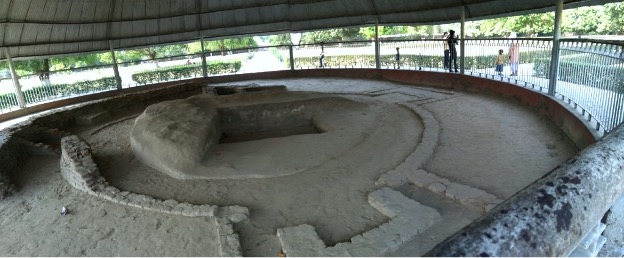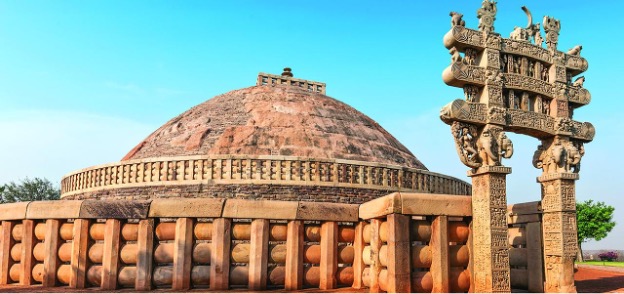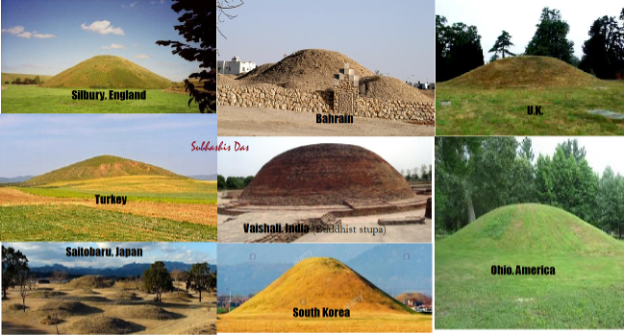by Subhashis Das
Independent Researcher
Stupas are an indispensible part of Buddhism and the monuments play a focal part in it. The word stupa is Sanskrit in origin which means a heap or a mound where as in the older Pali language the monument was known as thuppa.
After the cremation of the Awakened One in the Mahajanapada of Kusinagara by the Mallas of the region they kept his relics to themselves. This infuriated the mighty King Ajatshatru of Magadha, the Licchavis of Vaishali, the Koliyas of Ramagrama and the other republics and kingdoms which had them wage a war against the Mallas who eventually consented to distribute the ashes and the bones of the Lord among the seven other feuding republics and kingdoms. As per the advice of the Buddha, his holy relics were buried at significant crossroads and stupas of mud were raised on them for people to pay their respects by venerating them.

Asoka the Great is believed to have opened these eight stupas to fish out the ashes and bones of the Buddha from these early monuments. There after retaining a smaller amount of the relic inside the original mud stupa, Ashoka had them encased with bricks and subsequently on the extracted sacred relics he constructed several bricked stupas all over the country.
It is held that the Emperor had constructed 84000 stupas all over the subcontinent. Ancient India witnessed the building of a variety of architecture of monastic stupas from the 3rd century BC onwards; several had grand imposing structures while many of them were richly decorated.
India has many monastic stupas as Sanchi, Amravati, Vaishali, Kusinagara, Bahrut, Sarnath, Piparwa, Kesariya, Nagarjunakonda etc where the Buddhists pray and meditate.

Principally speaking India has three types of stupas: firstly, the saririka stupa which contains the bodily remains of Tathagata, secondly the paribhogika stupa which comprises his belongings and finally, the memorial stupas have been named as uddeshika stupa. Wherever Buddhism has travelled, to countries as Tibet, Cambodia, Burma and Mongolia etc; the cult of the stupa had taken a piggy-back ride with the religion. Buddhism in these countries merging with the local beliefs had the original architecture of the stupa altered hence has been ordained with different names.
But from where did the Buddhist stupa which is the nucleus of the Buddhist faith originate?
The first eight stupas on the Buddha’s bones and ashes were the mud stupas which were nothing but mound burials. In India the practice of mud heaps or mound burials were prevalent among the proto austroloid tribes, the non-Brahmanical paganistic believers and even among the people of the Brahmanical faith. They erected earth mounds on the burial of a dead child or of a holy person. Sramanas were also known to have been given live burials in meditative postures and earth stupas were consequently built on them.
Did the Sakas known as the Indo-Scythians brought their Kurgans or such burial mounds into the Indian subcontinent, is difficult to say?
Several megalithic communities as the Mundas, Asurs and the Oraons still build small burial mounds on their deceased infants or children and many even erect a stone circle on them. In local languages these burial mounds had a variety of names as dheep, bhisa et al. In Pali texts these burial mounds were called thuppas where as much later in Sanskrit corpus this was written as stupas.
Burial mounds are indeed appendages of the fertility cult that replicate hills symbolical of the pregnant womb of the ubiquitous Mother Goddesses. The fertility cult was endemic in most countries of the prehistoric world including India where several tribal communities apart from burial mounds erected megaliths which too were accessories of this cult. Several customs of this primitive cult have been absorbed into Hinduism today where as the tribals still practice many rites of this archaic faith.
The ancient cult of the stupa is not home-grown, neither do we know the country from which burial mound making may have has seeped into India during the prehistoric era. But given the fact that the primitive fertility cult had carpeted a large part of the world, much akin to India hills along with the earth were worshipped as the Mother Goddess. Megaliths and burial mounds were built on the dead as such mounds were regarded as the pregnant womb of the Great Mother.
Burial mounds on the dead as seen in Figure 4 were a world-wide custom and such mounds were raised on the relics of Tathagata. Ashoka’s deep reverence for the Buddha who had recommended a stupa be built on his remains persuaded Ashoka to make stupas an integral part of Buddhism. This unswervingly gave a fillip to stupa making hence we get to see different structures of stupas of that era both in India and abroad to wherever Buddhism travelled as Ashoka’s architects had constantly improvised on the primitive architecture of the burial mound.

In the last days of Buddhism in India stupa making was perhaps in its pinnacle. The stupa which began as simple earth heaps gradually rose to its height as complex and magnificent and imposing structures evident from the ones of Kesariya, Sanchi, Choukhandi and Dhamek etc. These structures being an essential ingredient of Buddhism were already infused with a whole different viewpoint subjective to Buddhism.
To join in the merit and share in the benefit, please support the Heart of the Mountain Dharma Refuge by contributing a tax-deductible donation through PayPal.

